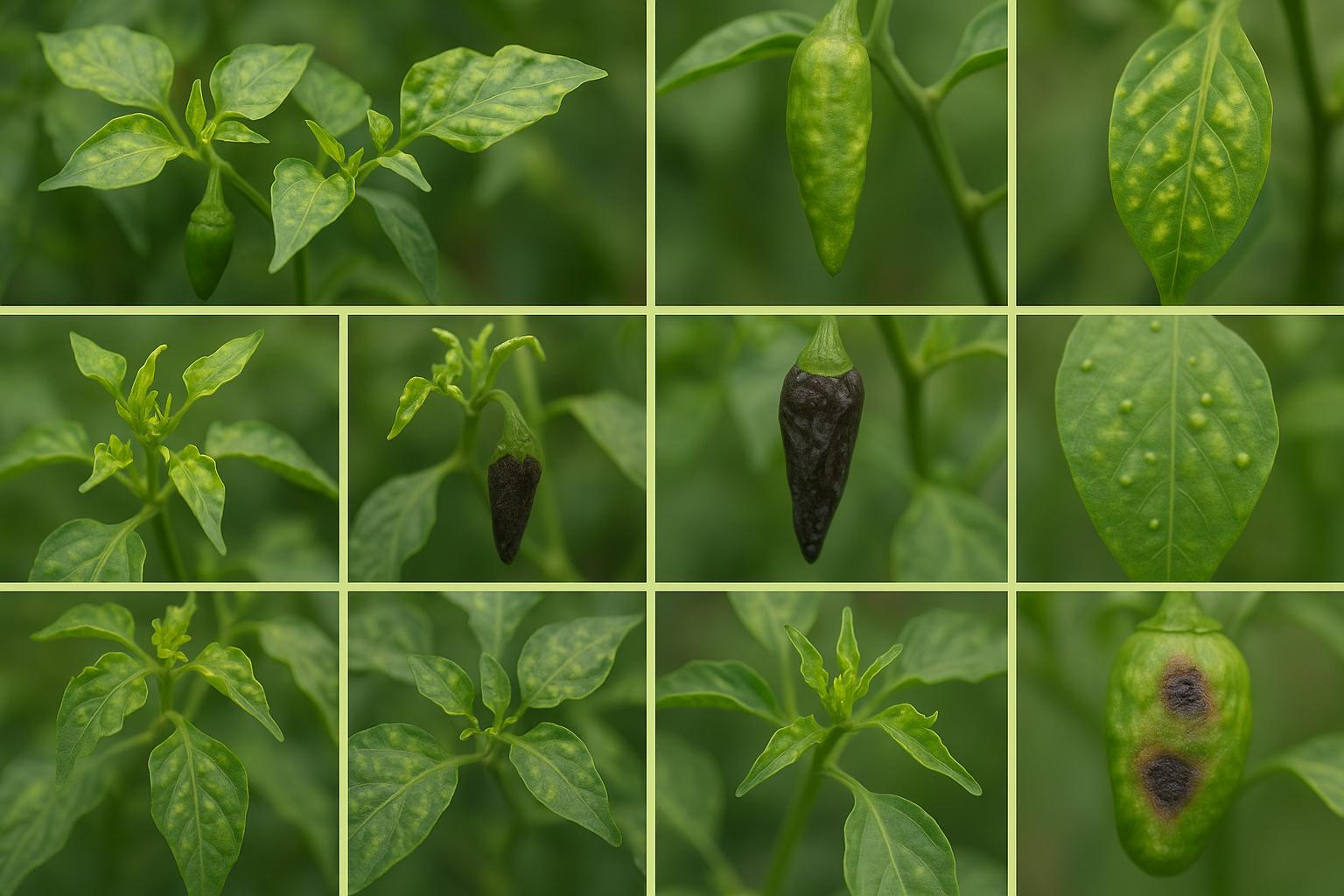Chilli farming can be both rewarding and unpredictable. One season your plants flourish; the next, they’re barely recognizable—leaves curling, fruits shrinking, growth slowing to a crawl. Viral infections in chilli plants are stealthy. By the time visible symptoms appear, the virus has already hijacked the plant’s inner systems. Knowing what to look for early can save your crop from severe damage.
This guide covers 10 critical signs that your chilli plants are under viral attack. Understanding these red flags and how they evolve will help you respond before your farm suffers irreversible losses.
Stunted Growth Despite Healthy Soil and Watering
One of the first signs of a viral presence is a general slowdown in plant growth. Unlike nutrient deficiency, where only specific parts may suffer, viral stunting affects the entire plant. You’ll notice:
- New leaves forming slowly or remaining abnormally small
- Shoots failing to elongate, leading to compact, bushy plants
Stunted growth is often the result of internal viral replication disrupting the plant’s hormonal balance and nutrient transport.
Distorted or Crinkled Leaves
Chilli viruses, particularly the notorious Chilli Leaf Curl Virus (ChiLCV), target leaf development. Infected plants begin showing twisted, cup-shaped, or crumpled leaves. This occurs because the virus alters cell formation during leaf emergence.
The affected leaves may also thicken or become leathery, creating a brittle texture that breaks easily under mild stress.
In many cases, early treatment with an antiviral foliar spray can prevent this symptom from worsening. For growers battling persistent infections, the Chilli leaf curl virus solution combines preventive and corrective actions by targeting the virus and improving plant immunity simultaneously.
Yellow Veins or Mosaic Patterns
When the veins of the chilli leaves begin to turn yellow or exhibit patchy mosaic-like patterns, it’s a strong signal of viral intrusion. Mosaic symptoms typically present as irregular blotches of light and dark green.
This isn’t just cosmetic—it indicates chlorophyll breakdown, meaning the plant’s photosynthesis is being actively disrupted. The result: slower energy production and poor fruit formation.
According to research published by the Indian Council of Agricultural Research (ICAR), leaf mosaic is among the top five indicators of viral infection in solanaceous crops like chilli and tomato.
Upward Leaf Curl
An upward curl along the edges of young leaves is a distinct warning sign, especially when accompanied by a shiny or thickened surface. This curling results from abnormal cell growth along the midrib and leaf margin—triggered by viral manipulation of plant hormones.
Upward curl typically begins on the apical leaves but spreads quickly if not contained. It’s often confused with heat stress, but viral-induced curling won’t correct itself even after environmental conditions improve.
Pale Green Shoots and Weak Stem Tips
Healthy chilli plants have a deep green hue. When viral infections strike, shoot tips often lose their pigmentation and look washed out. The plant’s growing points also become soft and susceptible to collapse.
At this stage, even mild handling can damage the top portions. Recovery becomes increasingly difficult once the apical meristem is compromised.
“Plants don’t wilt because they’re weak. They wilt because something’s draining their ability to fight.” – Rajan Mehta, Agronomy Advisor
Delayed or No Flowering
Chilli plants under viral attack often delay flowering or skip it altogether. Flowers, if they appear, may be deformed or drop before fruit sets. This is largely due to the virus blocking floral development at the bud formation stage.
In field conditions, infected plants often lag 2–3 weeks behind healthy ones in flowering. Early-season infection can lead to complete crop failure if not treated.
Poor Fruit Formation and Misshaped Chillies
Fruits formed under viral stress tend to be underdeveloped, wrinkled, or curved. Some may look sunken at one end or have an uneven skin texture. Others never grow beyond the size of a small pod.
These deformities reduce both market value and harvest volume. The capsicum viral complex is particularly notorious for distorting fruit tissues by interfering with cellular development post-pollination.
Purpling or Reddish Tints on Young Leaves
Anthocyanin accumulation—often seen as purpling of leaf edges or undersides—is another red flag. While sometimes linked to phosphorus deficiency, it’s also a sign of systemic viral stress where plant cells begin breaking down pigments.
If accompanied by crinkling or curling, it’s almost always virus-related.
Increased Whitefly Activity
Whiteflies serve as both viral carriers and food producers. You’re probably seeing the beginning of a viral outbreak if your chilli plants suddenly turn into a whitefly hotspot. After feeding, these flies spread viruses in a matter of seconds.
To track early population growth, use yellow sticky traps. Leaf problems often appear 10–14 days after a surge in whitefly populations.
The viral spread can be considerably slowed down by controlling whiteflies early on with neem-based sprays or suggested systemic methods. Consult CABI’s whitefly management guide for the most recent biological control alternatives.
A Cluster of Symptoms in Adjacent Plants
Rarely do viruses remain isolated. It’s likely that the infection is spreading quickly if you observe three or more of the aforementioned signs in several nearby plants. Viral infections are frequently spatial in nature, spreading from one plant to another by human contact or vector insects.
To prevent growth, isolate the impacted plants and concentrate your control efforts on the nearby areas. The remaining crop may be saved if severely affected plants are removed right away.
FAQs
- Can chilli viruses be transmitted through seeds?
Most chilli viruses, including ChiLCV, are not seed-borne. They spread mainly through vectors like whiteflies. However, poor sanitation during seed processing can carry other pathogens. - Will chemical insecticides stop viral spread?
Insecticides may kill vectors but won’t affect the virus inside the plant. Use them as part of an integrated approach with viral suppressants or plant protectants. - Do infected plants recover naturally?
Rarely. Once a virus penetrates the plant system, natural recovery is limited. Some resistant varieties may show partial symptom reversal, but most need intervention. - Is one viral infection more dangerous than another?
Yes. ChiLCV and Cucumber Mosaic Virus (CMV) are especially damaging in chillies. Mixed infections often result in faster decline and heavier yield losses.
What You Watch Is What You Save
Every farmer wants to see green, not sickly colors, and concentrate on growth. However, viral infections necessitate prompt notice, monitoring, and intervention. By identifying early warning indicators, you can become a proactive protector rather than a reactive grower.
Avoid waiting for symptoms to accumulate. Include plant walks in your daily schedule. Keep tabs on flower production, insect activity, leaf structure, and growth rate. Little adjustments frequently make a big impact.
Although they rarely happen suddenly, viral assaults have the power to completely destroy chilli farms. It’s your responsibility to identify the silent warning flags before they become obvious losses. Because success in farming is defined by what you prevent rather than merely what you grow.



